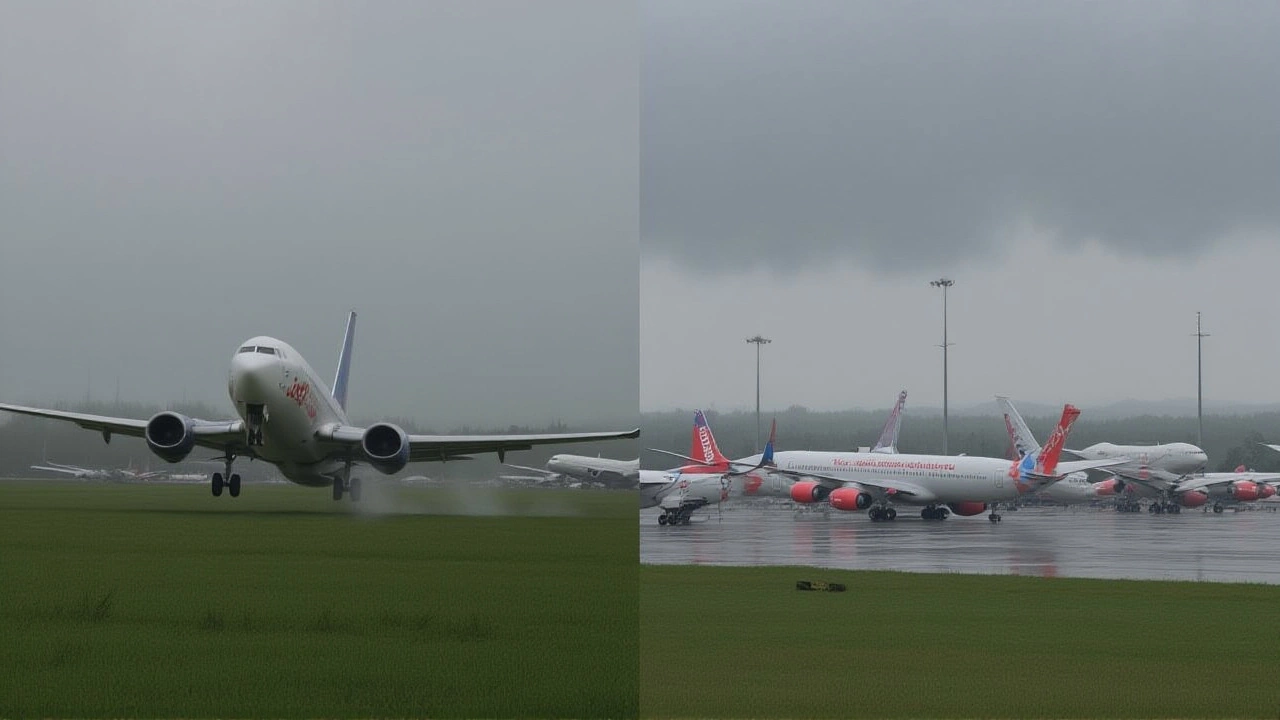When Leeds Bradford Airport was hit by Storm Amy on , the terminal turned into a pressure cooker of delays and cancelled take‑offs. The Met Office had already issued an amber wind warning for West Yorkshire, and by mid‑morning gusts were punching the runway at 58 mph, well over the airport’s 35 mph safety threshold. Paul Smith, the airport’s Operations Director, warned passengers that safety “remains our absolute priority,” while Sarah Jones, Head of Communications, was busy pushing updates on Twitter. Meanwhile, TUI Airways was scrambling to rebook travellers, and Richard Parker of the Yorkshire Air Ambulance had temporarily halted non‑essential flights. The scene was chaotic, but not entirely surprising given the ferocity of the storm.
Background: How Storm Amy Evolved
Storm Amy wasn’t a surprise. The Met Office’s low‑pressure system deepened rapidly over the Irish Sea on the night of October 3, drawing in cold northerly winds that slammed the Pennines. By 06:00 BST on the 4th, the amber warning covered the whole of West Yorkshire, forecasting gusts up to 90 mph for western Scotland and sustained winds north of 40 mph across Yorkshire. The storm’s name—assigned under the UK’s recent naming scheme—helps the public recognise the danger, and in this case the warning proved prescient.
Historically, Leeds Bradford Airport has seen weather‑related disruptions each winter, but Amy topped the recent record books. The last comparable event was the November 2021 blizzard that forced a 30‑minute runway closure. This time, however, the combination of wind shear and heavy rain made a safe landing almost impossible for larger aircraft.
Flight Disruptions and Safety Measures
At around 10:15 AM BST, a TUI Airways Airbus A330‑200 (G‑OOAL) attempted a hard‑right approach to Runway 14. Wind shear kicked in, forcing the pilots to abort. Video captured from the runway end showed the plane climbing back into the clouds, its nose jolting as gusts rattled the fuselage. The airport’s air traffic controllers responded by increasing separation distances between aircraft—some as much as 20 nm—to give pilots extra reaction time.
Runway 14 stayed open for the whole morning, but the number of movements dropped sharply. According to the airport’s operations log, at least 12 scheduled flights—TUI Airways to Alicante, Jet2.com to Palma de Mallorca, and Ryanair to Antalya—were either cancelled or delayed. The total passenger count for the day, based on 2022 data, would have been around 1,200, meaning several hundred travelers found themselves stranded.
Passenger Response and Rebooking Blitz
Inside Terminal 1, Michael Chen, Duty Manager for TUI Airways, was fielding a flood of upset customers. Between 09:00 BST and 13:00 BST, his team processed roughly 287 rebooking requests, most of which were shifted to the following day’s schedule. “We’re doing everything we can,” Chen told reporters, “but the weather isn’t something we can control.”
Passengers described the atmosphere as a mix of frustration and weary patience. One family from Manchester, arriving from the airport’s parking lot, said the line at the information desk stretched “almost to the departure gates.” Another traveler complained about the lack of hot drinks after a 30‑minute wait in the chill of the rain‑soaked concourse. West Yorkshire Police’s Airport Response Unit, led by Inspector Mark Thompson, stepped in to keep things calm, handling two minor incidents of unruly behaviour.
Local Authority and Emergency Services Coordination
Leeds City Council’s Emergency Planning Team, headed by Director of Resilience Catherine Walker, activated its Severe Weather Protocol at 08:00 BST. Through the Local Resilience Forum, council officials maintained a constant liaison with airport management, ensuring that the airport’s operational limits were respected and that any necessary public safety measures were in place.
The Yorkshire Air Ambulance, a vital service based at the airport, suspended all non‑essential missions from 09:30 BST to 13:00 BST. Chief Executive Richard Parker said, “Our crews and patients deserve safe conditions; we’ll only fly when the wind eases.” The decision, while disruptive for medical logistics, was praised by the CAA’s UK Airspace Policy Manager David Morgan, who noted that the airport’s wind thresholds are designed precisely for scenarios like this.
Impact on Travel and Airlines
- Key Fact 1: Wind gusts peaked at 58 mph at 11:42 BST, according to the Met Office station at Leeds (ID 03727).
- Key Fact 2: Approximately 287 passengers were rebooked by TUI Airways alone.
- Key Fact 3: The amber warning remained in force until 21:00 BST, covering the entire operational day.
- Key Fact 4: Jet2.com and Ryanair reported a combined loss of 1,500 seat‑kilometres of capacity.
Airlines issued statements emphasising passenger safety while apologising for the inconvenience. Jet2.com promised “full refunds or re‑routing” where possible, and Ryanair warned that some itineraries might not be re‑issued until the following week due to crew roster constraints.
Looking Ahead: What Comes Next?
By late afternoon, the wind began to subside, and the airport posted a tentative “operations returning to normal” banner on its website. Paul Smith said the team hoped to clear the backlog by the morning of October 5, assuming no further deterioration. The Met Office forecast a gradual weakening of Amy as it moves eastward, but warned of residual showers that could keep runway conditions slippery.
For travellers, the lesson is simple: check the airport’s live status feed before heading out, and keep an eye on the Met Office’s warning updates. As Sarah Jones reminded followers on Twitter, “We’ll keep you posted – safety first, travel second.”
Frequently Asked Questions
How many passengers were directly affected by the cancellations?
Based on the airport’s typical October traffic of roughly 1,200 passengers, and with 12 flights cancelled or delayed, analysts estimate that between 300 and 400 travelers missed their original itineraries.
What safety thresholds does Leeds Bradford Airport use for wind?
The airport triggers operational restrictions when sustained winds exceed 35 mph or gusts surpass 45 mph, with higher limits for larger aircraft like the Airbus A330‑200. Storm Amy’s gusts of 58 mph crossed those limits, prompting the cancellations.
Will airlines offer refunds for the disrupted flights?
Both TUI Airways and Jet2.com have said they will honour refunds or re‑routing at no extra cost. Ryanair’s policy is more restrictive, offering vouchers for future travel unless the disruption is classified as a “force majeure” event, which Storm Amy qualifies as.
How did the storm affect emergency services operating from the airport?
Yorkshire Air Ambulance suspended all non‑critical missions from 09:30 BST to 13:00 BST. The decision was made by its chief executive, Richard Parker, to avoid risking crew and patients in wind‑shear conditions.
When is normal flight schedule expected to resume?
Airport officials, led by Operations Director Paul Smith, anticipate most delayed flights will be cleared by the morning of October 5, provided that wind speeds stay below the 35 mph threshold and rain eases.




